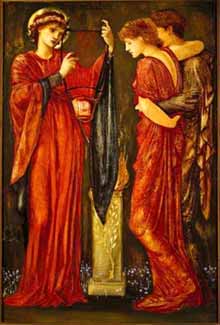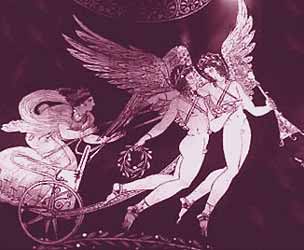 | |
| Of the five hawthorn trees in our yards, this one by the front door steps is the only one that has the multiple-trunked bush appearance. Of the others, three are much more like upright trees, & one is a twisted-trunked shrub. But this one, almost a fountaining shrub appearance, has to be regularly trimmed back as it grows much too rapidly. Growing near its foot is a Hino Crimson Azalea. In the background back by the fence is a Loder's White Rhododendron covered with May blooms. Another hawthorn tree, in full bloom on a hillside, is shown in the photograph below right. Underneath it you can make out some blue-green weeping limbs hanging over the fence. Those are volunteer Franchet's cotoneasters that self-seeded from two older shrubs higher on the hillside. | |
Myths & Legends
of Hawthorn Trees
"Every shepherd tells his tale
Under the hawthorn in the dale."
-John Milton
(1608-1674)
(1608-1674)
In Celtic lore the fairies had an affinity for the hawthorn which was one of the Three Sacred Trees, along with Oak & Ash. To this day in Ireland & Wales there are those who make hawthorn wreaths to leave out either for the fairies or for angels.
The number of superstitions & traditions attached to hawthorns are legion. For example, a thorn from a hawthorn can be kept in one's pouch while fishing to guarantee a good catch.
In Arabic erotic literature, hawthorn is regarded as an aphrodisiac because the flowers presumedly smell like aroused women. This is also why the hawthorn was sacred to Hymen or Hymenaeus, the Greek God of the marriage chamber. He was the son of Apollo & a Muse (Urania, Cleo, Caliope & Terpsicor are variously identified as his Muse mother). Or his mother was Aphrodite & his father Dionysios. Or according to Philostrates the Elder & other ancient commentators, Hymeanaeus & the other Erotes were hatched from eggs laid by sundry Naiads, wetnursed by Aphrodite, weaned onto golden apples that grew in the orchard of their naiad mothers. Aquatic flowers were sacred to them, & their steeds were swans which they in some ways resembled due to their own enormous wings & birdlike habits.
 The first home of Hymenaeus & his fellow Erotes was on Mount Helicon, but they were also frequently seen with the Curetes or Corybantes of Crete & Phrygia, these having been castrate priests of Cybele or Kar. Together the Karites & Erotes danced their noisy mountain-side dances. The walnut, which was sacred to Kar, was likewise sacred to Hymenaeus, as was Persephone's pomegranate. Hymenaeus is sometimes depicted bringing to weddings a large basket of nuts & fruits.
The first home of Hymenaeus & his fellow Erotes was on Mount Helicon, but they were also frequently seen with the Curetes or Corybantes of Crete & Phrygia, these having been castrate priests of Cybele or Kar. Together the Karites & Erotes danced their noisy mountain-side dances. The walnut, which was sacred to Kar, was likewise sacred to Hymenaeus, as was Persephone's pomegranate. Hymenaeus is sometimes depicted bringing to weddings a large basket of nuts & fruits.The Erotes were homosexual youths who served Aphrodite & held divine rule of sundry aspects of eroticism. They were said to be saffron-colored, usually the color associated with the garments of priestesses & goddesses. This is why in Byrne-Jones PreRaphaelite portrait of Hymenaeus playing his lute for a bride & groom, the god is dressed in the same saffron of the bride, the artist rather perversely elected overall to make Hymenaeus rather more feminine than the bride.
In one of Hymenaeus's myths which assumes him the son of Apollo, he was so lovely that he attracted the affection of Dionysios. Zeus became so jealous that he killed the boy, but Dionysios resurrected him with a tonic made from grape ivy.
Another tale assumes him the son of the mortal Magnes. Apollo fell in love with Hymenaeus & dwelt long in the house of Magnes. Hymen is elsewhere said to have been the lover of Thamyris & of Argynmus.
The Erotes were even free to love one another, being not literally brothers but only a brotherhood. Some of them were the sons of nameless naiads, but Hermaphrodites was famously the son of Hermes & Aphrodite, & Pothos the son of Aphrodite's attendant Iris & the Wind-god Zephyros. Hence no incest is implied by their erotic behavior toward one another.
 The vase painting at left shows two of the Erotes pulling Aphrodite's chariot. They are Hymenaeus with the lute he plays weddings, with Hemeros the god of Desire. The parentage of Hemeros is unknown, but he is as old as Aphrodite, having been waiting for her along with the Kharites or Graces when She first stepped out of the sea onto Kypros. Hemeros & Hymenaeus are shown with effeminate ardor embracing & gazing into one anothers' eyes, while Aphrodite drives them onward.
The vase painting at left shows two of the Erotes pulling Aphrodite's chariot. They are Hymenaeus with the lute he plays weddings, with Hemeros the god of Desire. The parentage of Hemeros is unknown, but he is as old as Aphrodite, having been waiting for her along with the Kharites or Graces when She first stepped out of the sea onto Kypros. Hemeros & Hymenaeus are shown with effeminate ardor embracing & gazing into one anothers' eyes, while Aphrodite drives them onward.Evening marriage processions culminated in the darkened nuptial chamber. Such processions were lit by torches made of hawthorn branches so that it could be said that Hymenaeus himself led the procession toward the marriage bed. Hymenaeus was typically portrayed as a winged effeminate youth carrying a lit brand made from a hawthorn branch, or a lute with which to sing wedding songs, or a basket of fruits symbolic of a fruitive union.
Hymenaeus led even Zeus & Hera to their nuptial bed, but for himself he never had a female mate. Though occasionally associated with the Graces in service of Aphrodite, there is no evidence that Hymenaeus or any Erote other than Eros (who desparately loved Psyche) was ever attracted to the opposite sex.
Quite naturally therefore, Hymenaeus was not a god of heterosexual marriages only, but of any union like unto a marriage. For example, Iphis was a maiden who liked dressing as a youth, & sought to marry her true love, pretty Ianthe. The two maidens took marriage vows with the blessings of Hera, Aphrodite & Hymenaeus. Ovid reports that Iphes said, "Why shoud not Hymenaeus preside over a marriage with no groom, when both of us are brides!"
The Erotes were by name Eros, Pothos, Anteros, Hedyloges, Hermaphroditus, & Hymenaeus, plus Zeus's catamite Ganymedes was often their companion. Despite their eternal youthfulness & delicate natures, they were sometimes very warlike. Indeed Anteros was said to be the son of Ares, & was an avenger of unrequited love, though Aelian in On Animals said that Anteros was the improbable offspring of Poseidon & his catamite charioteer, the youthful Sea-god Nerites; so perhaps Anteros had some of the same traits as Hermaphroditus!
Many a war had its beginnings in rivalries over objects of love or intended marriages gone awry. Hymenaeus was the god of wars that began over matters of desire, such as the Trojan War.
The Erotes, Amores, or Cupides were thus called "loud & roaring." A poetic fragment quotes Anacreon the bard singing to the Erotes: "You are violent & wicked! You know not where you throw your spear!" In such contexts Hymneaus is the son of Apollo by Urania the Muse of Song, & he personifies foremost wedding songs, but also songs of war. With the other Erotes, he serves violent forms of Aphrodite who more resembled raging Cybele, such as Aphrodite Urania who slew her lovers on mountain-tops, or the Amyclaian Aphrodite who rode a war-chariot & was armed with a spear similar to the hawthorn-hafted weapon Hymenaeus bore into battle.
Hawthorn was additionally sacred to the Greek Goddess Maia (Roman Flora). For this reason boughs were long used for luck & for protection in Greek & Roman households, & remained symbolic of hope well into the Christian era.
But in Teutonic ritual it was used for funeral pyres because smoke of the hawthorn bore souls into the afterlife. The Hawthorn's association with death gave rise to many frightful superstitions about this tree.
 On the witches' holiday of Beltane (May Day), witches were supposed to be able turn themselves into Hawthorns. The greatest of all goddess-witches, Nimue, had her great victory over Merlin when she snared him eternally in the thorny branches of a hawthorn.
On the witches' holiday of Beltane (May Day), witches were supposed to be able turn themselves into Hawthorns. The greatest of all goddess-witches, Nimue, had her great victory over Merlin when she snared him eternally in the thorny branches of a hawthorn.Modern wiccans & neo-druids keep some of the traditions about hawthorn alive, notably a very old peasant practice from England of hanging ribbons on hawthorns during their May bloom. The lingering rustic practice consists of hanging a rag on a hawthorn at the crossroads for luck & for the granting of wishes. But Wiccans, for Beltain, will hang a pink ribbon in a hawthorn to wish for love, a blue ribbon to wish for protection, a green ribbon to wish for wealth, & a purple or indigo ribbon to wish for greater occult knowledge.
Christianization did not deter British fondness for hawthorn magic. The Burning Bush seen by Moses was said to have been a hawthorn. The crown of thorns on the head of Jesus was a hawthorn wreath, a myth that lent itself to hawthorn's oldest divine associations with Death & equally with Life.
In yet another Christian myth, the walking staff that Joseph of Arimathea possessed was a hawthorn branch. When he came to Glastonbury, his staff was inserted into English soil, where it grew into the largest hawthorn tree anywhere in the Isles. A giant specimen long held to be that very tree was cut down by Cromwell's thugs.
 Due to its association with the death of Jesus & with witchcraft, it was also commonly believed that if a hawthorn died, or if a hawthorn were harmed even for cuttings of the May flowers, there would be bad luck or death within the family.
Due to its association with the death of Jesus & with witchcraft, it was also commonly believed that if a hawthorn died, or if a hawthorn were harmed even for cuttings of the May flowers, there would be bad luck or death within the family.In medieval England the tree was believed to be a dwelling place for the Fair Folk, who could cause good or bad luck. If their hawthorn were cut down, the tree-murdering miscreant's life would be forfeit for his misdeed; but whomever cared for such a tree would have have good fortune bestowed upon them by the Fair Folk.
It was additionally believed that if one were to hang a sprig of hawthorn in the barn, this would cause cows to give better milk. A hawthorn sprig in the rafters of a home helped to keep bogarts, ghosts, & evil spirits at bay.
Trees that most impacted human communities are the ones that acquired the most legends over time. The richness of Hawthorn mythology is just one more reason I'm glad I inherited these little trees around our home.
To read about the specific hawthorns in our gardens,
jump to the main article about
Our Hawthorn Trees
See also these subsidiary pictorial pages:
Hawberries in Autumn
Hawthorn's Winter Bark
Hawberries in Winter